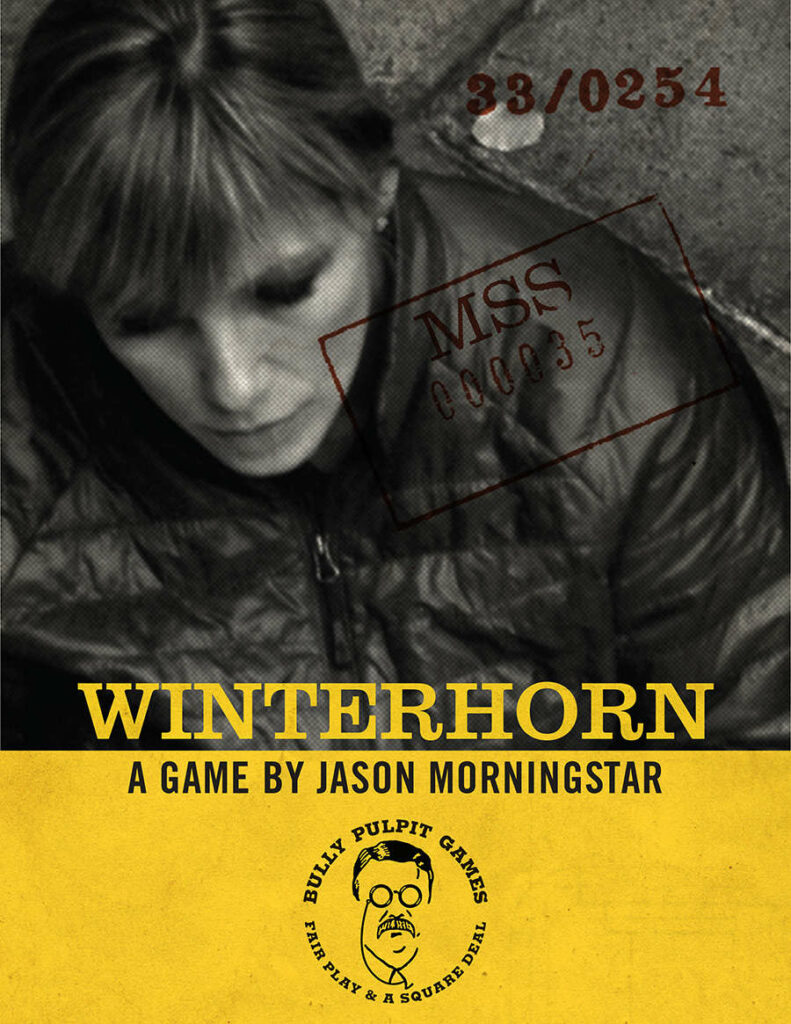I’m on a study project to improve my understanding of roleplaying games. To this end, I already have two reading projects, A Game Per Year and An Adventure Per Year. This is the third, with the goal of reading or playing 52 games made in the last few years. Originally I considered making this “A New RPG Per Week” and that’s where the number 52 comes from, even though a weekly schedule is probably not within my abilities.

Winterhorn occupies an interesting niche in the participatory game landscape. It’s both subtle and blatant, marginal and mainstream, psychological and procedural, real and fictional. It’s a chamber larp about a governmental task force who’s job is to crush the activist group codenamed Winterhorn.
The game is card-based, with participants playing characters with different motivations and biases choosing strategies for dealing with Winterhorn and then reacting to the outcomes. The basic flow of the game consists of debates over the right strategy choices (gamified into cards) and then seeing what they lead to.
The game is set in an abstracted state that could be anything from East Germany to modern Canada. There’s a worldbuilding pamphlet that’s an in-game object created by the activists and written in a playfully American tone while other aspects of the aesthetic resemble old school East Europe.
The abstraction serves the game’s purposes in the sense that the main thing is the mechanisms of subversion available to the characters, not the specifics of time and country. The abstraction is further heightened by the use of code names for the targets.
The psychological design of the game has other subtleties too. As the players get caught up in the game, questions of right and wrong recede, supplanted by the desire to win. After all, they have a clear enemy, tools, win and lose conditions. The setup echoes the reality of real government agents with similar tasks.
The centerpiece of the game is a series of methods for destroying Winterhorn. These include surveillance, setting up front groups and straight up violence. All are actual, real strategies used by intelligence and security agencies the world over to suppress dissent.
This is where Winterhorn transcends the usual self-definition of games as mere entertainment. It’s explicitly presented as a tool you can use to teach yourself strategies of suppression and how to detect and resist them in case they’re applied to you. There’s even a booklet with extra rules on how to run the game as a simplified workshop for this purpose.
Personally, I’ve never been enough of an activist to experience this kind of suppression. Still, when I was younger I participated in a protest action in Belgium called Bomspotting to highlight the presence of illegal nuclear weapons at the Kleine Brugel airbase. More experienced activists pointed out the white vans and anonymously dressed cops photographing us.
Some aspects of the activist culture I experienced at the time were purposefully designed to make the group more difficult to infiltrate. For example, activists played silly team building games on public squares. When I wondered about it, I was told that in their experience, undercover agents find such frolics unbearably embarrassing, making the group harder to penetrate. Thinking back to it, I like this example of using playfulness as a mode of resistance.
Winterhorn is excellent both as a game and as a learning tool. One of the things I like about it is that the government task force is not omnipotent. They can succeed or fail. The history of real life intelligence agencies is rife with stupidity, something that Hollywood movies about hypercompetent CIA agents often obscures.